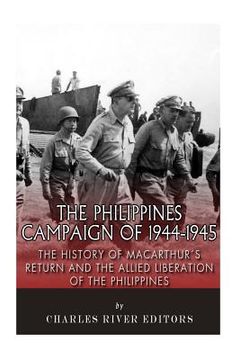The Philippines Campaign of 1944-1945: The History of MacArthur's Return and the Allied Liberation of the Philippines
Synopsis "The Philippines Campaign of 1944-1945: The History of MacArthur's Return and the Allied Liberation of the Philippines"
*Includes pictures *Includes a bibliography for further reading *Includes a table of contents "I came through and I shall return." - General Douglas MacArthur As American and Filipino troops were in the process of being defeated in the Philippines, on the night of March 12, 1942, General Douglas MacArthur, his family and closest advisors were smuggled out of the Philippines on PT boats. From there they surged across the black ocean to Mindanao and were picked up by American B-17 bombers. They stealthily flew to northern Australia, a dangerous flight over Japanese-held territory, and at Adelaide on March 18, 1942 that MacArthur met the assembled press and told them, "I came through and I shall return." The words would go down in history, and MacArthur would eventually fulfill the vow. In the wake of the campaign, Japan occupied the country and went on to expand their territory in the Pacific, while at the same time destroying the American presence in that region, but by the spring of 1943, American military planners had begun to create a plan to dislodge Japan from east and southeast Asia. To do so, parts of the Philippines were considered main strategic points in the potential Allied attack in the Pacific. The end goal of the Allied plan was an invasion of the Japanese home islands, in which heavy aerial bombardment would precede a ground assault. In order for this to occur, Allied forces would have to occupy areas surrounding Japan, with China adding to Luzon (the largest island in the Philippines) and Formosa (a large island off the coast of China) to create a triangle from which they could launch their bombers. The Allied advance across the Pacific was based on this 1943 plan, with General MacArthur and his forces moving to the north through New Guinea, then Morotai Island, and then to Mindanao, which was the southernmost major island in the Philippines chain. At the same time, Admiral Chester Nimitz sent his fleet through the central Pacific, where they engaged Japanese forces at the Gilbert, Marshall, Marianas and Palau Islands en route to Mindanao. As the Allies advanced, American strategists became embroiled in a discussion over whether to stick to the 1943 plan, or whether to focus their efforts on seizing Formosa, from which they would be able to create a supply link to China and would also be able to cut Japanese communication lines to the south. By the time the campaign started, Japan was on the defensive, but as they would prove in other places like Iwo Jima and Okinawa, Japanese soldiers would act fanatically before admitting defeat or surrendering. During this second major Philippines campaign, an estimated 330,000 Japanese died, and only a bit more than 10,000 were willing to be taken prisoner. In fact, some Japanese soldiers engaged in guerrilla warfare on the Philippines well after the campaign had ended and even after Japan had formally surrendered, prompting the Japanese emperor to personally make a visit and intervene to end the fighting. The Philippines Campaign of 1944-1945: The History of MacArthur's Return and the Allied Liberation of the Philippines chronicles the campaign from the start to its aftermath. Along with pictures of important people, places, and events, you will learn about the campaign like never before.

